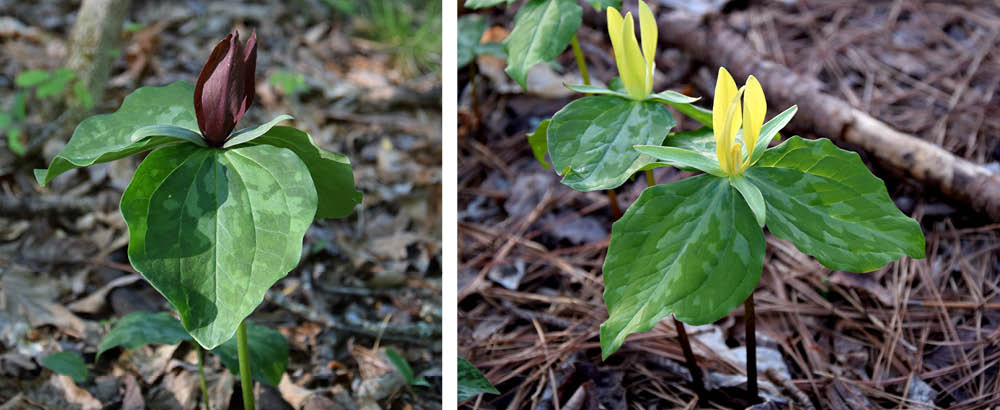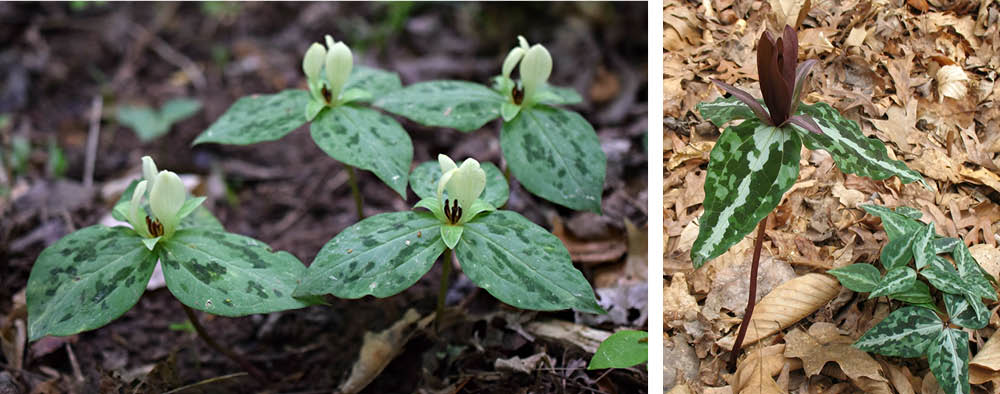Georgia holds a special honor when it comes to trilliums: Georgia has more indigenous species than any other state –22 species as of 2010 with more actively being evaluated for species level. Trilliums are fairly uncommon plants in general and are much cherished by native plant lovers. In undisturbed places there can be thousands of individual plants. However, most of us have a chance to see only a few here and there. I found 3 on our new property in 2003. Over the last 17 years, a few more have popped up, no doubt from seed sown long ago. It takes at least 7 years for a seed to become a flowering plant.
Trilliums are so named because so many of the parts come in “threes”: 3 leaves, 3 sepals, and 3 petals–all of which are visible to even the most novice of observers. The plants grow from underground rhizomes that gradually increase in size each year. Trilliums are “ephemeral” plants, usually fading in the hot weather and then remaining dormant until spring. Seeds form in fruit structures called “berries”; each of the small brown seeds is attached to a creamed-colored eliasome which is attractive to ants. Ants gather these seeds so that they can eat the nutritious eliasome, helping to disperse the seeds in the process.
One of the best experts on Georgia trilliums was Tom Patrick with GADNR (Georgia Department of Natural Resources). He spoke to our native plant society in 2010 and provided a wonderful handout. Most of this information is pulled from that resource.
Tom’s handout divides them into two groups: the Wakerobins and the Toadshades. These two groups are distinctly different in appearance so this separation makes sense. He has further divisions within those two groups; if you want more information, please use the link above to read further as he deserves all the credit for that work.
This month, I want to share information and photos for the Toadshades, known generally as the sessile group. They are the earliest to appear and flower in both north and south Georgia. Next month I’ll cover the Wakerobins. Tom described the Toadshades as “Trilliums with attractively mottled leaves; flowers sessile (no distinct flower stalk, the flower sitting directly on top of the leaves).”
The species in this group include: Trillium cuneatum, T. decipiens, T. delicatum (newly described in 2019), T. decumbens, T. discolor, T. lancifolium, T. ludovicianum (a GA NW population that Tom referenced, now considered T. freemanii), T. luteum, T. maculatum, T. reliquum, and T. underwoodii.
Trillium cuneatum is by far the most common and widespread of the toadshade trilliums – even more so than indicated by the USDA and BONAP maps as my county’s populations are not represented. Often called Sweet Betsy, this species was our plant of the year in 2017. There is quite a bit of variance in color forms in the species – most petals are deep burgundy but some can be almost green. Even the sepals can vary from green to burgundy. Occasionally, individuals with multiple leaves have been found – I’ve seen as many as 12 leaves on a single plant. The degree of mottling is also variable; I have seen leaves that are almost entirely silver, with very few spots. In very NW Georgia, T. freemanii is similar in appearance but has an unpleasant odor.
Trillium discolor and Trillium luteum may both seem to resemble green forms of T. cuneatum, but they have distinct features that separate them. I love the unique lemon-y fragrance of T. luteum which is usually found in in rich mature forests on calcareous substrates. T. discolor can also be distinguished in the wild by where it is found: in the Savannah River drainage basin near Toccoa.
While some species are uniquely northern, others are uniquely elsewhere. Long before those of us north of Atlanta find the earliest blooming Trilllium cuneatum, southern residents are enjoying not only that species but also the blooms of Trillium maculatum and T. underwoodii. In mid-Georgia, one can also find Trillium decipiens and T. reliquum. Note: These are general locations, based on BONAP data.
Other mottled trilliums that are fairly unique in their appearance are Trillium decumbens and T. delicatum—both of which appear to sit flat on the ground but are found in different environments; and T. lancifolium—a petite and slender species, often in colonies.
So if you find one of our mottled trilliums, you might want to dive into the details of where it is located as well as some of the finer points of its appearance before you decide exactly which species it is. Or feel free just to enjoy these special Georgia plants just for being there. Georgia plants are what make Georgia be uniquely Georgia.




